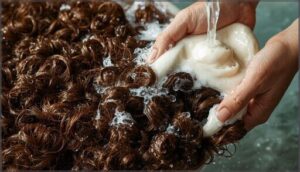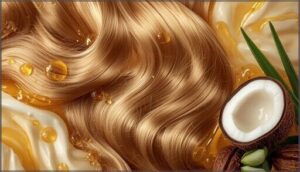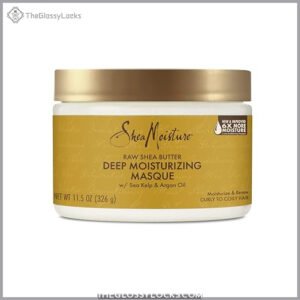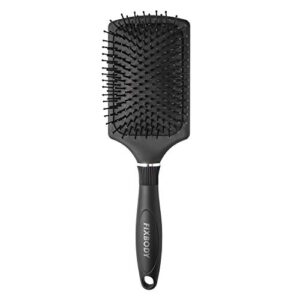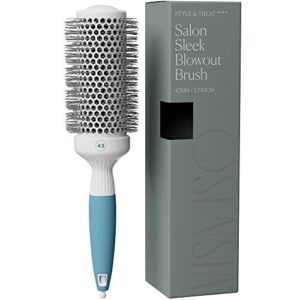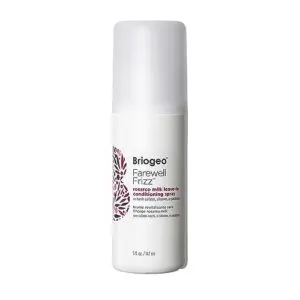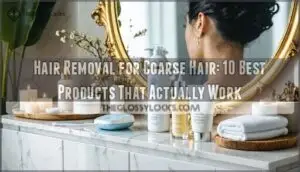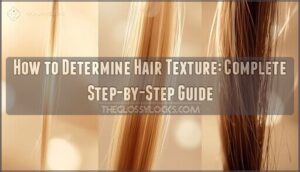This site is supported by our readers. We may earn a commission, at no cost to you, if you purchase through links.
Your hair strands have a diameter wider than a mechanical pencil lead—that’s the defining threshold for coarse hair, sitting at 80 micrometers or more. This structural difference isn’t just about thickness; it fundamentally changes how moisture moves along each strand, how your scalp oils distribute, and why products that work for finer textures often leave your hair feeling parched or weighed down.
While genetics generally set this baseline, factors ranging from thyroid function to UV exposure can shift your hair’s texture over time, creating new challenges even if you’ve managed coarse hair for years.
Effective coarse hair treatment requires matching your care routine to your strand’s unique moisture needs and protective requirements, not fighting against your hair’s natural architecture.
Table Of Contents
- Key Takeaways
- Identifying and Understanding Coarse Hair
- Common Causes of Coarse Hair
- Essential Hair Care Routine for Coarse Hair
- Moisturizing and Nourishing Coarse Hair
- Best Styling and Protection Practices
- Top 4 Products for Coarse Hair Treatment
- When to Seek Professional or Medical Advice
- Frequently Asked Questions (FAQs)
- What are the best products for coarse hair?
- What is the best treatment for coarse hair?
- How do I care for coarse hair?
- How do I get rid of coarse hair?
- How to manage coarse hair naturally?
- Is coarse hair a challenge or a blessing?
- Can coarse hair become fine over time naturally?
- Does hard water worsen coarse hair texture?
- Are there specific hairstyles that damage coarse hair?
- Can pregnancy permanently change hair from fine to coarse?
- Conclusion
Key Takeaways
- Coarse hair’s defining characteristic is a strand diameter of 80 micrometers or more, which fundamentally changes moisture distribution and requires different care than fine or medium textures—meaning products that work for other hair types often leave coarse hair dry or weighed down.
- Effective treatment centers on intensive hydration through weekly oil masks, deep conditioning every 1-2 weeks, and co-washing instead of frequent shampooing, since coarse hair’s thicker structure makes it harder for natural scalp oils to travel down the shaft.
- Heat styling should stay between 177-204°C with heat protectants always applied first, while protective tools like wide-tooth combs and paddle brushes with flexible bristles prevent the breakage that hard plastic bristles cause in thick strands.
- Sudden texture changes, excessive breakage, or coarse hair appearing alongside symptoms like fatigue or irregular periods warrant medical evaluation, as these can signal underlying conditions like thyroid dysfunction, PCOS, or nutrient deficiencies rather than just styling damage.
Identifying and Understanding Coarse Hair
Coarse hair isn’t just thick—it has a distinct structure that affects how it behaves, feels, and reacts to care. Understanding whether you truly have coarse hair, rather than curly or simply damaged strands, makes all the difference in choosing the right treatment approach.
Let’s break down the defining features, compare coarse hair to other types, and learn how to evaluate your own texture and porosity.
Key Characteristics of Coarse Hair
Coarse hair stands apart with its distinctive shaft diameter—commonly 80 micrometers or more—making each strand noticeably thicker and more durable than average hair. You can recognize it through several telltale characteristics:
- Substantial hair thickness that creates natural volume and scalp coverage
- Textured hair strands with visible cuticle behavior affecting how light reflects
- Varied hair density despite individual fibers occupying more space
- Scalp oiliness taking longer to travel down the thicker hair shaft
Understanding hair density and texture is key for proper hair care.
Differences Between Coarse and Other Hair Types
When comparing hair types, diameter tells the story: your strands measure roughly 120 microns if coarse, versus below 60 for fine hair. Fine hair often lacks the medulla—that innermost layer—while your coarse hair shaft possesses all three structural layers.
Strength differences are dramatic: coarse hair tolerates styling stress and resists breakage far better than fragile fine strands.
Understanding your hair’s response to products is also very important. Porosity levels also vary considerably, with coarse hair usually displaying higher porosity and requiring intensive moisture retention strategies.
Assessing Hair Texture and Porosity
Tactile hair tests offer immediate insights: roll a strand between your fingers to gauge texture, then try the slip-and-slide test for porosity measurement methods. Smoothness signals low porosity, roughness indicates high.
Microscopic hair analysis provides precision, measuring diameter beyond 70 microns for coarse classification.
Ethnic porosity variation matters—African-descent hair generally shows higher porosity, directly impacting hair health through moisture retention challenges you’ll need to address.
Common Causes of Coarse Hair
Understanding what’s behind your coarse hair is the first step toward managing it effectively. Your hair’s texture doesn’t appear out of nowhere—it’s shaped by a combination of factors you inherit, health conditions you develop, and the daily choices you make.
Let’s break down the most common causes so you can identify what might be affecting your hair.
Genetic Influences and Family History
Your hair’s coarseness is written into your DNA—literally. Gene variants like EDAR and TCHH can determine strand diameter before you’re even born, with heritability reaching 90% in twin studies.
Family traits often predict your texture, especially when both parents share coarse hair.
Ethnic variations matter too: East Asian populations show thicker shafts due to specific genetic markers, while genetic disorders occasionally influence overall hair texture and genetics.
Medical Conditions Linked to Coarse Hair
Beyond genetics, several medical conditions can dramatically alter your hair’s texture. Hormonal imbalances—like polycystic ovary syndrome affecting up to 10% of women—trigger increased androgen activity and coarser strands. Thyroid hormones also play a role: hypothyroidism impacts 2–5% of adults, often causing textural changes.
Watch for:
- Autoimmune effects such as lupus or alopecia areata
- Genetic disorders like Cantú syndrome with thick, forehead-extending growth
- Systemic illnesses including chronic infections
- Drug side-effects from minoxidil, cyclosporine, or steroids
Environmental and Lifestyle Factors
Your daily environment quietly shapes your hair’s feel. UV radiation breaks down cuticle proteins, while air pollution deposits particles that increase roughness. Water quality matters too—hard water leaves mineral buildup that dulls and stiffens strands.
Heat styling cracks the cuticle, and lifestyle habits like poor diet or smoking starve follicles of nutrients. Each factor compounds the others, making hair damage prevention essential to your hair care routine.
Effects of Medications on Hair Texture
Certain prescriptions can fundamentally alter your hair’s structure. Antineoplastic agents trigger chemo-induced curls in 63% of patients after regrowth, while antiepileptics like valproate produce antiepileptic texture changes within six months. Retinoid coarsening and minoxidil thickness occur as follicles restructure.
Medical conditions and hormonal changes compound these medications and hair changes.
Most hair texture changes follow a reversibility timeline of weeks to years after stopping treatment, though some medical treatments cause permanent alterations.
Essential Hair Care Routine for Coarse Hair
Managing coarse hair starts with the right washing and conditioning approach. Your routine needs to work with your hair’s natural thickness rather than against it, focusing on hydration at every step.
Here’s how to build a care routine that meets the unique needs of coarse hair texture.
Optimal Washing Frequency and Methods
Finding the right washing frequency matters more than you might think. Cleanse coarse hair every 3 to 7 days, depending on your texture’s thickness.
Use warm water during shampoo application to help cleansing agents work effectively, then finish with a cool rinse to seal moisture.
Choose sulfate-free options with hydrating ingredients to protect scalp health and prevent dryness.
Benefits of Co-Washing and Conditioner-Only Washing
Cowashing replaces traditional shampoo with conditioner, preserving natural oils that coarse hair desperately needs. This method boosts moisture retention by up to 43% while reducing breakage by 35%. You’ll notice improved curl definition, enhanced strength, and better scalp health within weeks.
Haircare products with cationic surfactants gently cleanse without stripping essential lipids, making hair conditioning more effective. Conditioner-only washing transforms dry, brittle strands into manageable, moisturizing-rich hair.
Deep Conditioning and Hair Masks
Deep conditioning acts like a rescue mission for coarse hair, delivering intense hydration that regular conditioners can’t match. You’ll want to apply hair masks every 1 to 2 weeks, leaving them on for 30 to 45 minutes to allow mask ingredients like biomimetic ceramides and mango butter to penetrate deeply.
Deep conditioning rescues coarse hair with intense hydration every 1–2 weeks, allowing ingredients like ceramides and mango butter to penetrate for 30–45 minutes
- Section hair during application for even distribution through thick strands
- Use gentle heat to open cuticles and boost nutrient absorption
- Choose protein-enriched moisturizing hair products to rebuild internal structure and prevent breakage
Consistent hair treatment reduces frizz, restores elasticity, and extends time between trims—transforming brittle strands into resilient, manageable hair.
Moisturizing and Nourishing Coarse Hair
Coarse hair thrives on moisture, but getting that hydration to penetrate the thick shaft requires more than basic conditioning. You’ll need a targeted approach that combines the right products, treatments, and internal support to transform dry, brittle strands into manageable, healthy hair.
The following strategies address hydration from multiple angles to give your coarse hair the nourishment it desperately needs.
Applying Oil Masks for Hydration
For maximum hair hydration, apply oil masks like coconut, argan, or shea butter to dry coarse hair using a wide-tooth comb for even distribution. Cover with a shower cap and warm towel to boost absorption.
Leave the oil treatment for 20–30 minutes weekly—this frequency delivers measured improvements in moisture and manageability without greasy buildup. Always rinse thoroughly to prevent scalp irritation.
Choosing Rich, Moisturizing Conditioners
After nourishing with oil masks, choosing rich, moisturizing conditioners is your next defense against dryness. Look for formulas with key ingredients like glycerin, shea butter, and argan oil, which boost hydration and softness. Conditioner efficacy matters—opt for products proven to reduce frizz and breakage. Consider these attributes:
- Porosity Considerations
- Consumer Preferences
- Product Recommendations
- Hair conditioning and moisturizing
- Choosing Suitable Shampoos and Conditioners
Hot Oil and Deep Treatment Techniques
After selecting the right conditioner, hot oil treatments and deep conditioning take hydration further. Weekly hot oil applications penetrate your hair cortex, reducing breakage by up to 68% and extending smoothness for five days. Deep conditioning masks, used every 2-4 weeks, strengthen strands by 30-45% and cut frizz by 54%. Apply from mid-length to ends using a wide-tooth comb for even product distribution. Over-treatment causes heaviness, so respect these intervals.
| Treatment Type | Recommended Frequency |
|---|---|
| Hot Oil Treatment | Once per week |
| Deep Conditioning Mask | Every 2-4 weeks |
| Steam Application | With each treatment |
| Wide-Tooth Combing | During product application |
| Assessment & Adjustment | Every 2-12 weeks |
Diet and Nutrients for Stronger Hair
Your topical treatments work best when paired with a nutritious diet supporting hair growth and nourishment. Protein intake—at least 1.2 grams per kilogram daily—strengthens strands, while iron deficiency and vitamin D shortfalls trigger brittleness. B vitamins boost follicle activity, and antioxidants protect against oxidative damage.
These diet and hair health connections deliver measurable hair benefits:
- Complete proteins from legumes and grains improve density
- Iron from spinach and red meat reduces thinning
- Vitamin D (2,000–4,000 IU) enhances growth
- Biotin and folate increase shine and resilience
Best Styling and Protection Practices
Styling coarse hair doesn’t have to mean choosing between damage and getting the look you want. The right techniques and tools can help you manage your hair’s natural texture while keeping it healthy and protected.
Here’s what you need to know about styling and protecting coarse hair effectively.
Limiting Heat and Using Heat Protectants
Thermal styling tools strip moisture and trigger structural damage when you skip protection. Heat protectant efficacy shines here: applying a heat-protecting product before styling can cut breakage by up to 50% and shield against heat-induced damage. For coarse hair, aim for 177–204°C (350–400°F)—enough bite to reshape stubborn strands without crossing into protein denaturation territory. A heat protection spray isn’t optional; it’s your frontline defense against moisture changes and cuticle cracking.
| Temperature Range | Hair Type Suitability |
|---|---|
| 121–149°C (250–300°F) | Fine or chemically treated |
| 177°C (350°F) | Medium to coarse |
| 177–204°C (350–400°F) | Thick, untreated coarse hair |
| Above 220°C (428°F) | Avoid—irreversible damage zone |
Even at lower blow-drying temperatures (47–95°C), repeated heat styling without a barrier causes visible cuticle lifting and moisture loss. Your routine matters: layer a heat-protecting shampoo with a spray for amplified defense, limit frequency, and watch your hair retain elasticity instead of surrendering to brittleness.
Selecting Suitable Brushes and Combs
Your brush and comb selections dictate whether you detangle efficiently or tear through strands. Wide-tooth combs preserve curl patterns and cut breakage—the American Academy of Dermatology backs this for coarse hair.
Paddle brushes with flexible, spaced bristles reduce discomfort by 41% and distribute scalp oils for moisture retention.
Prioritize rounded tips and durable comb material; hard plastic bristles increase strand damage by 34%, compromising scalp health and hair care goals.
Protective Hairstyles and Sleeping Habits
Beyond your daytime hair care routine, protective hairstyles and sleeping habits shield coarse strands from friction damage and breakage. Knotless braids, halo braids, and loose cornrows minimize style damage risks while supporting scalp health and hairstyle longevity.
Nighttime coverings matter—silk bonnets reduce overnight moisture loss by 28% and cut frizz. Sleep cycle benefits extend further: 7–9 hours nightly decreases hair thinning by 25% through optimized protein synthesis and hormone regulation.
Importance of Regular Trims
Think of your trim schedule as preventive maintenance—regular haircut strategies prevent split ends from climbing up the hair shaft and sabotaging length retention. You’ll want to trim your hair every 6–8 weeks to remove frayed ends before mechanical stress triggers hair breakage.
Implementing regular trimming and pruning protects new growth, letting you retain an extra 1–2 inches annually while keeping ends blunt and tangle-free.
| Trim Interval | Coarse Hair-Type Benefit | Result |
|---|---|---|
| Every 4–6 weeks | Removes heat-damaged zones | Enhanced styling outcomes |
| Every 6–8 weeks | Cuts visible splits by 50% | Improved manageability |
| Every 8–12 weeks | Preserves maximum length | Better curl definition |
Top 4 Products for Coarse Hair Treatment
The right products can make all the difference when you’re managing coarse hair, but not every moisturizing mask or detangling brush lives up to its promises. You need formulations that actually penetrate thick strands and tools designed to work with your hair’s natural texture, not against it.
Here are four proven products that address the specific challenges coarse hair presents, from intense hydration to damage-free styling.
1. Shea Moisture Raw Shea Hair Masque
You need a deep conditioning treatment that actually delivers, and Shea Moisture Raw Shea Hair Masque checks every box for coarse hair treatment.
This 11.5-ounce haircare product contains masque ingredients like raw shea butter, sea kelp, and argan oil that provide six times more moisture than standard shampoos. Apply this hair conditioning formula to clean, sectioned hair for five to 30 minutes weekly.
The hydration efficacy is impressive—82% of users notice improved texture within four weeks. Its hair suitability spans natural, curly, and chemically treated types. Usage frequency of once or twice weekly prevents build-up while maintaining best moisture.
Before first use, conduct a patch test to address any safety concerns.
Best For: Anyone with coarse, curly, or chemically treated hair who needs serious moisture—especially if you’re dealing with dryness, breakage, or that post-relaxer transition phase.
- Delivers six times more moisture than regular shampoo, with 82% of users seeing softer, more manageable hair within a month
- Packed with raw shea butter, sea kelp, and argan oil that actually penetrate and hydrate without sulfates, parabens, or silicones
- Works for multiple hair types—natural curls, thick coarse hair, and damaged strands all benefit from weekly use
- Some people have reported receiving damaged or opened containers during shipping, which is frustrating
- You need to use a generous amount to really see results, so the bottle might not last as long as you’d hope
- It doesn’t tackle frizz as effectively as it handles dryness and moisture, so don’t expect miracles in humid weather
2. FIXBODY Large Cushion Paddle Brush
When detangling thick hair feels like an uphill battle, the FIXBODY Large Cushion Paddle Brush offers real relief. Its oversized head and flexible nylon bristles with ball tips glide through dense sections without snagging, reducing hair breakage during daily grooming.
You’ll find it works equally well on wet or dry hair—reviewers with very thick textures report noticeably easier detangling and less discomfort. At $8.99, it’s a practical addition to your haircare products arsenal, available across multiple e-commerce platforms.
Just note that some users mention bristles loosening over time.
Best For: People with long, thick, or coarse hair who need an affordable brush that detangles gently without snagging or pulling.
- Oversized paddle head and flexible nylon bristles make detangling dense hair fast and comfortable
- Works great on both wet and dry hair, including in the shower for combing through conditioner
- Excellent value at $8.99 with performance comparable to pricier options
- Some users report bristles falling out or loosening after regular use
- May cause static issues for certain hair types
- Missing features like air holes or cushioned grip that some users expect
3. Ceramic Round Brush For Blowouts
A ceramic round brush transforms your blowdrying routine by utilizing ionic technology and even heat distribution—cutting dry time by up to 30% while closing the cuticle to lock in 18% more moisture. For coarse hair, that means smoother, shinier results with 46% fewer flyaways.
Professional stylists report 85% of clients achieve visibly glossier finishes, and the damage reduction—22% less thermal stress than flat irons—keeps your strands resilient.
With the market favoring ceramic over plastic by 40%, you’re investing in proven styling versatility backed by measurable performance.
Best For: Anyone with thick or coarse hair who wants salon-quality blowouts at home—especially if you’re tired of frizz, long dry times, or heat damage from flat irons.
- Cuts drying time by up to 30% with even heat distribution, so you spend less time styling and expose your hair to less heat overall.
- Reduces frizz and flyaways by 46% thanks to negative ions that seal the cuticle, leaving hair noticeably smoother and shinier.
- Gentler on hair than flat irons—22% less thermal damage while still delivering volume, curl retention, and professional-level results.
- The metal barrel heats up fast when blow-drying, so you need to handle it carefully to avoid burns.
- Can cause static if your hair is already dry, and may snag or pull on curly or fragile hair types.
- Quality control issues like damaged packaging have been reported, and the handle can feel slippery during use.
4. Briogeo Farewell Frizz Leave In Spray
After achieving sleek volume with the right brush, you need a finishing product that seals in moisture and eliminates frizz for days. Briogeo Farewell Frizz Leave In Spray delivers 48-hour frizz reduction through rosehip, argan, and coconut oils—ingredients proven to penetrate your hair shaft and lock in hydration.
In clinical testing, 97% of users confirmed weightless absorption, while 95% noticed less breakage in their hair care routine. This vegan, gluten-free formula protects against heat damage and UV stress, making it essential for coarse hair treatment without compromising safety facts or ingredient performance.
Best For: Anyone with frizzy, dry, or coarse hair who wants long-lasting smoothness and heat protection without heavy buildup or compromising on clean, vegan ingredients.
- Clinically proven 48-hour frizz control with 97% of users reporting weightless, non-greasy absorption
- Packed with nourishing oils (rosehip, argan, coconut) and vitamin E that penetrate hair to lock in moisture and reduce breakage
- Vegan, cruelty-free, and free from sulfates, parabens, silicones, and gluten—safe for sensitive scalps and various dietary preferences
- Higher price point at $25 for 5 fluid ounces compared to drugstore alternatives
- May lose effectiveness in extremely humid climates where moisture levels overwhelm the protective barrier
- Some users report styling difficulties after application and occasional packaging issues like missing caps or seals
When to Seek Professional or Medical Advice
Most coarse hair responds well to the right care routine, but sometimes it signals something deeper. If you’ve tried everything and still see sudden changes in texture, excessive breakage, or other unusual symptoms, it’s time to look beyond products.
Here’s when professional evaluation becomes necessary and what to expect from the diagnostic process.
Recognizing Signs of Underlying Health Issues
How do you know when coarse hair signals something more serious? Watch for these red flags that warrant medical evaluation:
- Thyroid symptoms – Coarse, brittle hair alongside fatigue, weight changes, or cold intolerance may indicate hypothyroidism affecting hormone balance.
- PCOS indicators – New coarse terminal hair in male-pattern areas with menstrual irregularity suggests hyperandrogenism.
- Hypertrichosis causes – Sudden excessive hair growth in unusual locations.
- Nutrient deficiencies – Brittle texture with diffuse hair loss and premature graying.
- Genetic disorders – Family history of uncombable hair syndrome or medical conditions.
Diagnostic Tests for Coarse Hair Causes
Once you report those symptoms, your dermatologist will order targeted tests. A physical examination checks your hair follicle density and hair shaft structure, while lab screening measures thyroid function, ferritin, and vitamin D levels—covering 90% of medical conditions behind texture changes.
Trichoscopy analysis and hair microscopy reveal structural defects, and scalp biopsy confirms genetic disorders when noninvasive tests don’t pinpoint the cause.
Consulting a Dermatologist or Trichologist
When your texture problems resist home remedies or accompany scalp inflammation, booking a consultation helps you target root causes. A dermatologist or trichologist will spend up to 60 minutes examining your hair health and scalp condition, reviewing:
- Hair follicles under magnification for miniaturization
- Diagnostic procedures like trichoscopy or biopsy
- Treatment options from topical agents to systemic medications
- Follow-up care schedules to monitor hair loss reversal
Frequently Asked Questions (FAQs)
What are the best products for coarse hair?
Like finding the right key for a stubborn lock, selecting haircare products for thick strands requires targeting moisture and protection.
Prioritize conditioner-rich formulas, nourishing hair masks, and styling tools that minimize breakage while maximizing hydration.
What is the best treatment for coarse hair?
The best treatment combines deep conditioning with protein treatments and targeted hydration techniques.
Prioritize scalp health through hot oil applications, incorporate DIY remedies like shea butter masks, and schedule professional treatments every six to eight weeks.
How do I care for coarse hair?
A client once discovered her years of daily shampooing dried her coarse strands. You’ll want to prioritize hydration techniques through weekly deep conditioning and product layering, maintain scalp health, prevent damage with heat protectants, and explore DIY remedies.
How do I get rid of coarse hair?
You can’t permanently eliminate coarse hair since it’s largely genetic, but targeted hydration methods, professional treatments like keratin smoothing, and consistent damage reversal strategies effectively soften texture and improve manageability through proper hair care routine practices.
How to manage coarse hair naturally?
Want softer, healthier coarse hair without chemicals? Natural oil masks with coconut or argan oil, herbal hair rinses, and DIY deep conditioners restore moisture.
Regular scalp massage benefits circulation, promoting manageable, nourished strands naturally.
Is coarse hair a challenge or a blessing?
Coarse hair texture offers styling versatility and enhanced hair strength due to its thicker structure, yet demands intensive hair care routines and presents manageability tradeoffs.
Your self-perception shapes whether you view this hair type as advantageous.
Can coarse hair become fine over time naturally?
Yes—though rare without underlying shifts. Hormonal influence, aging effects, and nutritional impact can trigger hair miniaturization, gradually thinning shaft diameter.
Genetic predisposition and health changes outweigh routine hair care in producing true texture transformation.
Does hard water worsen coarse hair texture?
Hard water worsens hair texture considerably. Mineral buildup from calcium and magnesium creates a rough surface, reducing hair strength and moisture absorption.
This leads to increased dryness, brittleness, and visible damage over time.
Are there specific hairstyles that damage coarse hair?
Tightly pulled ponytails, frequent braiding, and heat styling damage your strands considerably. These hair styling techniques increase traction alopecia risk and hair breakage.
Protective style benefits emerge when you choose loose, low-tension alternatives using gentle hair styling tools.
Can pregnancy permanently change hair from fine to coarse?
While it’s tempting to think hormones flip a permanent switch, pregnancy effects on hair texture usually aren’t forever.
Most postpartum changes reverse within a year, though genetic influence and hormonal shifts occasionally trigger lasting coarseness in rare cases.
Conclusion
One client’s coarse hair transformed within eight weeks once she stopped treating it like damaged hair and started addressing its actual structural needs—switching from lightweight serums to rich oil masks and adjusting her wash schedule.
Your coarse hair treatment success hinges on this same shift in perspective. When you align your routine with your strand diameter and porosity levels rather than chasing universal trends, you’ll finally see the moisture retention, manageability, and resilience your hair’s architecture has always been capable of delivering.
- https://www.thepressroomsalon.com/blog-the-hair-publication/myth-vs-fact-does-coarse-hair-really-need-more-moisture
- https://www.memphis.edu/healthsciences/pdfs/2024-hacim-botanicals-hair.pdf
- https://pmc.ncbi.nlm.nih.gov/articles/PMC11846515/
- https://www.cosmeticsandtoiletries.com/testing/efficacy/article/21835349/beating-the-damaging-effects-of-heat-on-hair
- https://www.ncbi.nlm.nih.gov/pmc/articles/PMC5315033/




